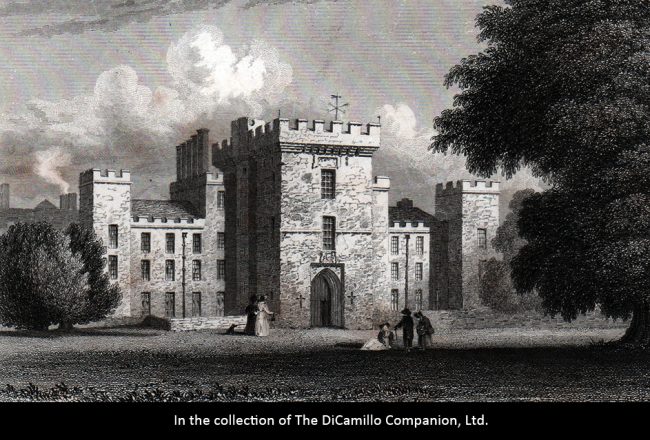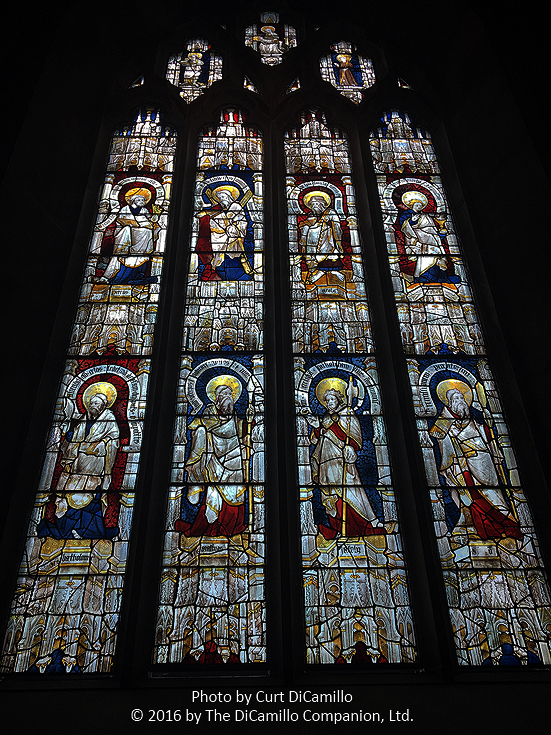
An 1830 engraving of the House from "Neale's Views of Seats"

The 15th century window, formerly in the Chapel at Hampton Court Castle, today in the collection of the Museum of Fine Arts, Boston.
Built / Designed For: Sir Rowland Lenthall
House & Family History: Hampton Court, Herefordshire, is one of the largest medieval manor houses in England. Sir Rowland Lenthall was given a license to crenellate in 1435. It was Lenthall who put up the quadrangular, partly fortified, manor house. The Coningsbys purchased the estate in 1510 (Disraeli used the family name for the hero of his novel). Thomas, 1st Earl of Coningsby, brought about enormous changes at Hampton Court; circa 1706-10 he regularized the 15th century façade and engaged George London to lay out the gardens. The Estate remained in the 1st Earl's family and passed by marriage into the possession of Viscount Malden, later 5th Earl of Essex, in 1781. Soon after inheriting, Viscount Malden put into action significant changes in the Gothick style, probably designed by James Wyatt. J.M.W. Turner visited Hampton Court in 1795 and produced important watercolors and pencil sketches of the Estate. Many of the watercolors are today in the collection of the Whitworth Art Gallery at the University of Manchester. Two of the Turner watercolors at the Yale Center for British Art in New Haven, Connecticut, were commissioned by Sir Richard Colt Hoare in 1806 to illustrate his copy of Thomas, Earl of Coningsby's private publication of "An Account of the Manor of Marden in Hertfordshire," 1722-25. John Arkwright, grandson of industrialist Sir Richard Arkwright, inventor of the spinning frame, purchased Hampton Court in 1810. The greatest transformation of the House began in the 1830s and was mostly to the designs of the amateur architect Charles Hanbury-Tracy, later 1st Lord Sudeley (the earlier attribution of this work to Jeffry Wyatville has now been disproved). The architects John and William Atkinson advised Arkwright, but the rebuilding of the House seems now clearly to have been to the designs of Hanbury-Tracy. The Arkwright family lived at Hampton Court until 1912, when they sold up to a Mrs. Burrell. In 1924 Mrs. Burrell sold the House to Viscountess Hereford; the viscounts Hereford held the property until 1972, when it was sold to Capt. The Hon. Philip Smith. In 1975 Hampton Court was sold again, this time to George Hughes, who completely restored the House In 2006 businessman Graham Ferguson Lacey purchased Hampton Court and 1,000 acres for £10 million. Though he makes his primary residence on the Isle of Man, Lacey maintains Hampton Court as one of his homes. A stained glass window, considered one of the finest produced in England in the early 15th century (1420-35), formerly in the Chapel at Hampton Court, is today in the collection of the Museum of Fine Arts, Boston, who purchased it in 1925 (see photo in "Images" section). The window, considered the finest medieval stained glass in America, was once part of a larger window that probably displayed all 12 Apostles (the window today shows eight of the Apostles) and the Pieta. Above the Apostles' heads are long scrolls with Latin inscriptions from the Apostles' Creed. All but one has his name on the dais below his feet. As a result of its 21st century conservation, and examination of stonework at Hampton Court, scholar Madeline Caviness has been able to pinpoint the window's original location – in the west wall of the south transept of Hereford Cathedral. It was very likely removed from the cathedral in the 1640s during the English Civil War to prevent Parliamentarians from destroying its papist imagery. The window was installed in the Chapel at Hampton Court after the Restoration and was completely in place by 1683 (it was likely at this point that the window was cut down in size, losing four of the Apostles, to enable it to fit into the Chapel at Hampton Court). Caviness attributes the glass painting to John Thornton of Coventry, the artist responsible for the Great East Window in York Minster.
Collections: Leonard Knyff (1650-1722) painted two views of Hampton Court, formerly part of the collection of the House and now at the Yale Center for British Art, New Haven, Connecticut. The Yale Center also has two views of the House by J.M.W. Turner and a view by John Stevens (died 1722). The Turner watercolors at Yale were commissioned by Sir Richard Colt Hoare in 1806 to illustrate his copy of Thomas, Earl of Coningsby's private publication of "An Account of the Manor of Marden in Hertfordshire," 1722-25. The State Bed from Hampton Court, made circa 1698 for Thomas, Baron Coningsby, is today in the collection of The Metropolitan Museum of Art, New York City; it was at Hampton Court until 1925. A settee with a scrolling foliage pattern, originally made in England for Hampton Court, 1690-1700, is today in the collection of the Victoria & Albert Museum, London.
Garden & Outbuildings: The gardens were designed by George London in the French style and are famous for their allées. London apparently worked under the supervision of William Talman, who may have designed the cruciform temple. There was also a large Neptune fountain in the gardens, described by Tom Lyttleton in 1758. Today the gardens include an organic walled Kitchen Garden, canals, pavilions, a maze, a secret tunnel to a waterfall, and the flooded Sunken Garden.
Architect: George London
Date: Circa 1706-10Architect: James Wyatt
Date: Post 1781Architect: Charles Hanbury-Tracy (Sudeley)
Date: 1830s-40sArchitect: William Talman
Date: 1706-10Vitruvius Britannicus: C. II, pls. 57, 58, 1717. C. III, pl. 75, 1725.
John Bernard (J.B.) Burke, published under the title of A Visitation of the Seats and Arms of the Noblemen and Gentlemen of Great Britain and Ireland, among other titles: Vol. II, p. 250, 1853.
John Preston (J.P.) Neale, published under the title of Views of the Seats of Noblemen and Gentlemen in England, Wales, Scotland, and Ireland, among other titles: 2.S. Vol. III, 1826.
Country Life: XXX, 750 [Furniture], 787 [Furniture], 902 [Furniture], 1911. CLIII, 450, 518, 582, 1973.
Title: Sunday Times, The (London)
Author: NA
Year Published: NA
Reference: Rich List 2008, pg. 80
Publisher: London: Times Newspapers Ltd.
ISBN: NA
Book Type: Newspaper
Title: V&A Guide to Period Styles: 400 Years of British Art and Design, The
Author: Jackson, Anna; Hinton, Morna
Year Published: 2002
Reference: pg. 34
Publisher: London: V&A Publications
ISBN: 0810965909
Book Type: Hardback
Title: Burke's & Savills Guide to Country Houses, Volume II: Herefordshire, Shropshire, Warwickshire, Worcestershire
Author: Reid, Peter
Year Published: 1980
Reference: pg. 33
Publisher: London: Burke's Peerage
ISBN: 0850110319
Book Type: Hardback
Title: Country Houses in Great Britain
Author: NA
Year Published: 1979
Reference: pgs. 23-26, 84
Publisher: New Haven: Yale Center for British Art
ISBN: 0930606191
Book Type: Softback
Title: MFA: A Guide to the Collection of the Museum of Fine Arts, Boston
Author: Wohlauer, Gilian Shallcross
Year Published: 1999
Reference: pg. 185
Publisher: Boston: Museum of Fine Arts, Boston
ISBN: 0878464727
Book Type: Softback
Title: Biographical Dictionary of British Architects, 1600-1840, A - SOFTBACK
Author: Colvin, Howard
Year Published: 1995
Publisher: New Haven: Yale University Press
ISBN: 0300072074
Book Type: Softback
House Listed: Grade I
Park Listed: Grade II
Current Seat / Home of: Graham Ferguson Lacey; here since 2006.
Past Seat / Home of: Sir Rowland Lenthall, 15th century. Thomas Coningsby, 1st Earl Coningsby, 17th-18th centuries; Coningsby family here 1510 until; 1781. William Anne Holles Capell, 4th Earl of Essex, 18th century. John Arkwright, 19th century; Arkwright family here 1810 until 1912. Mrs. Burrell, 1912-24. Robert Devereux, 16th Viscount Hereford, 20th century; Devereux family here 1924 until 1972. Capt. The Hon. Philip Smith, 1972-75. George Hughes, 1975-?
Current Ownership Type: Individual / Family Trust
Primary Current Ownership Use: Private Home
House Open to Public: Yes
Phone: 01568-797-777
Fax: 01568-797-472
Email: [email protected]
Website: http://www.hamptoncourt.org.uk
Historic Houses Member: No